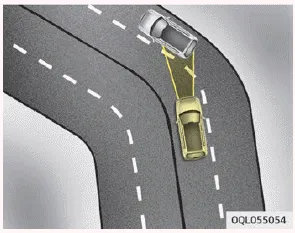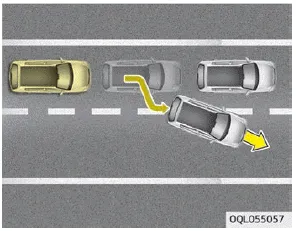Kia Picanto (JA): Radar type autonomous emergency braking / Limitation of the system
The AEB is an assistant system for a driver in a certain risky driving condition and it does not take every responsibility for all risks from driving condition. The AEB monitors the driving situations through the radar. Thus, for a situation out of the sensing range, the AEB may not normally operate. The driver should pay great caution in the following situations. The AEB operation may be limited.
Recognizing vehicles
- Sensor or sensor cover is contaminated
with foreign substances.
- It heavily rains or snows.
- There is interruption by electric
waves.
- There is severe irregular reflection
from the radar.
- The vehicle in front has a narrow
body. (i.e. motor cycle)
- In situations when there is severe radar
reflection, the AEB may not operate
normally. (parking lot, iron bridge,
etc.)
- Special vehicles (bus, truck, constructive
vehicle, trailer, etc.) in which radars
are difficult to detect, the AEB
may not operate normally.
- The vehicle in front is a special vehicle,
such as a heavily-loaded truck or
a trailer.
- The vehicle driving is unstable.
- The radar sensor recognition is limited.
- Driving on unpaved and uneven road
surfaces, or through sudden gradient
changes.
- In construction zones or on railroad
tracks, or there are metallic objects
on the road.
- Driving indoors such as in an underground
parking lot.
- Driving in an underground parking lot.
- Entering a tunnel or tollgate.
- There are materials which easily reflect
radar signals. (guardrails, approaching
vehicles, etc.)

- Driving on a curve
The AEB performance decreases while driving on a curve. The AEB may not recognize the vehicle in front even in the same lane. It may unnecessarily produce the warning message and the warning alarm, or it may not produce the warning message and the warning alarm at all. While driving on a curve, pay great caution, and, if necessary, depress the brake pedal.

While driving on a curve, the AEB may recognize the vehicle in front in the next lane. Pay great caution, and, if necessary, depress the brake pedal. Or, depress the accelerator pedal to maintain the driving speed. Always, take a look around the vehicle for your safety.

- Driving on a slope
The AEB performance decreases while driving upward or downward on a slope, not recognizing the vehicle in front in the same lane. It may unnecessarily produce the warning message and the warning alarm, or it may not produce the warning message and the warning alarm at all. When the AEB suddenly recognizes the vehicle in front while passing over a slope, you may experience sharp deceleration.
Always keep your eyes forward while driving upward or downward on a slope, and, if necessary, depress the brake pedal.

- Changing lanes
Even though the vehicle in the next lane enters into your lane, it may not be recognized by the AEB, until it enters the AEB sensing range.
Especially when the vehicle in the next lane abruptly enters into your lane, it is more likely not be recognized. Always pay great attention.

When the stopped vehicle in front gets out of the lane, it may not be recognized by your AEB. Always pay great attention.

- Recognizing the vehicle
When the vehicle in front has heavy loading extended rearward, or when the vehicle in front has higher ground clearance, it may induce a hazardous situation.
WARNING
- Cancel the AEB in the User Settings on the LCD display, before towing another vehicle. While towing, the brake application may adversely affect your vehicle safety.
- Pay great caution to the vehicle in front, when it has heavy loading extended rearward, or when it has higher ground clearance.
- The sensor only detects vehicles, not carts, bicycles, motorcycles, luggage bags, or strollers.
- The AEB does not operate in a certain situation. Thus, never testoperate the AEB against a vehicle or an object. It may cause a severe injury or even death.
NOTICE
The system may temporarily cancel due to the strong electric waves.
When the AEB is not working properly, the AEB warning light ( ) will illuminate and the warning message will appear for a few seconds.
Your vehicle's fuel economy depends mainly on your style of driving, where you drive and when you drive. Each of these factors affects how many kilometers (miles) you can get from a liter (gallon) of fuel.
Other information:
Kia Picanto (JA) 2017-2025 Service & Repair Manual: Start/Stop Button
Components and components location Component Repair procedures Removal 1.Disconnect the negative (-) battery terminal. 2.Remove the crash pad lower panel. (Refer to Body - "Crash Pad Lower Panel") 3.Remove the steering column shroud lower panel.
Kia Picanto (JA) 2017-2025 Service & Repair Manual: Power Window Switch
Components and components location Components Driver Power Window Switch Connector Pin Information [All Manual / Auto Down Type] (LHD) No. Description No.
Categories
- Manuals Home
- Kia Picanto Owners Manual
- Kia Picanto Service Manual
- Fuel Delivery System
- Battery Sensor
- Normal Condition
- New on site
- Most important about car
